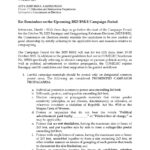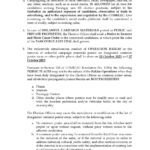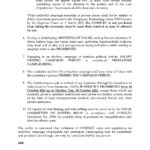With the campaign period for the 2023 Barangay and Sangguniang Kabataan Elections kicking off in 2 days – October 19, 2023 – the COMELEC just released some very important reminders. Click the thumbnails below, to enlarge.
The list starts off with the reminder that lawful campaign materials should be posted only in designated common poster areas. These common poster areas are designated typically by local COMELEC offices, usually in places that see high levels of pedestrian traffic. There’s a whole bunch of rules dealing with common poster areas, but that’s dealt with a little farther down on this list. In fact, item number one on this list is not actually about common poster areas but about what is considered to be UNLAWFUL ELECTION PROPAGANDA. In other words, kung anu-ano ang mga campaign materials na pinagbabawal.
So, ano nga ba ang ipinagbabawal? Well, the usual. Oversized posters, posters and other printed materials that don’t contain the disclosures “Paid for” and “Paid by,” and (a COMELEC favorite) posters that are placed next to each other to make a bigger picture or to spell out a name. Interestingly, the list of prohibited campaign materials now includes – as a new addition – the prohibition against content that violates the RA 9710, or the Magna Carta of Women. I say this is interesting because this is the first content-based restriction, some would say “prior restraint,” to be implemented by the COMELEC.
And rounding off the first item on the list, is a reminder that has caused considerable confusion among candidates who, I must admit, are confused only because they tend to cherry-pick what to take away from an otherwise clear, albeit grammatically deficient, rule. The rule in question reads:
“Posters or tarpaulins bearing the image of candidates, whether individually, by group, or of the whole slate, which exceed 2×3 feet.”
The unfortunate decision to use emphasize “candidates etc” by putting those words in boldface have led many, either sincerely or with malice, to misinterpret this reminder as prohibiting campaign materials that show candidates whether individually or as a group. This interpretation is flat-out wrong because it ignores the final proviso “which exceed 2×4 feet.” In other words, this is just a restatement of the basic rule na bawal ang campaign materials na lampas ang sukat sa 2×3. To be very clear ok lang na may picture or image ng kandidato or ng slate, basta hindi lalampas ang sukat sa 2×3.
Item number 2 reads:
“Campaigning in groups and posting campaign propaganda in groups ARE ALLOWED as long as the poster is in accordance with the size requirement.”
I understand why COMELEC felt the need to specify this since one of the most common bits of mis- and disinformation making the rounds is that candidates are no longer allowed to campaign in groups. This is obviously false. Hindi nga ‘yan pinagbawal nung pandemya, ngayon pa kaya?
Item number 3 on the COMELEC’s list of reminders basically says that the use of media – traditional and social – for campaigning is allowed, with practically no limitations, except for the rules on authorized expenses. This differs from the media-use rules in past National and Local Elections in that in those other elections, there were caps on the number of minutes of advertising airtime, caps on the frequency of print ads, etc.
Now it could be that the change in rule – basically the elimination of time-limits and frequency caps – is simply because these are barangay elections and not national and local elections, but this new formulation is worth watching. There is a very real possibility that this seemingly minor change is a relatively minor elections will later on be introduced as a massive change in the political advertising landscape of the 2025 midterm elections and beyond. So, #payattention.
Item number 4 reiterates that unlawful campaign materials posted in public (of course) and PRIVATE (yo, Archdiocese of Bacolod fans!) can be subject of a Notice to Remove and a Show Cause Order to the concerned candidates, both of which might conceiably lead to a take-down of the materials in question. If you find this hard to square with your preconceived notions on this topic, read the Supreme Court decision again. And not to put too fine a point on it, the reminder explicitly states:
“While unlawful campaign materials in private places shall not be subject of Baklas Operations pursuant to the Temporary Restraining Order issued by the Supreme Court on 1 March 2022, the COMELEC is not precluded from taking the necessary steps to cause their removal as may be allowed by law.”
Item number 5 on the COMELEC list deals with common poster areas and Operation Baklas. Strangely, this item specifies that Operation Baklas cannot touch locations designated as common poster areas which I thought was self-evident. In any case, the reminder goes on to clarify that list of designated common poster areas CAN be amended in the proper instances.
Item number 6 specifies that giving anything of value – covering basically everything campaigns traditionally give away – “during and after a public meeting or campaign sortie” is prohibited. I think it’s very laudable that the COMELEC is signalling that it will strictly enforce this ancient rule this time around. It’ll be interesting to see how many people take the COMELEC up on this challenge.
Item number 7 says that campaigning outside of the campaign period is to be considered premature campaigning – a semantically interesting choice considering that campaigning on the day before the elections is technically outside of the campaign period, but can in no way be characterized as premature.
Item number 8 is another new rule apparently. It says
“The candidate and five of his/her campaign staff may wear a T-shirt with the candidate’s picture DURING THE CAMPAIGN PERIOD.”
While I appreciate the apparent motivation behind this rule, I expect that there will be many who will find ways to circumvent. Expressio unius est exclusio alterius and all that.
Item number 9 talks about the prohibition on giving assistance through the Assistance to Individuals in Crisis Situations from October 20 to 30, while specifying the exemptions, i.e., assistance “normally given to qualified individuals such as but not limited to basic needs in the form of food, transportation, medical, educational, burial and other similar assistance.” I believe the use of the term AICS is inreference to the DSWD program.
And finally, item 10 emphasizes that all reports of vote-buying and vote-selling should be acted on by local Kontra-Bigay committees, pursuant to COMELEC Resolution 10946.
The list is closed out by one final – and extremely relevant and important reminder:
“The public cautioned that violations of COMELEC Rules and Regulations on unlawful campaign propaganda and premature campaigning may be committed and penalize accordingly, not only by candidates but by any person.”
Well said.




